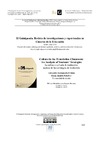Please use this identifier to cite or link to this item:
https://accedacris.ulpgc.es/handle/10553/70294
| Title: | Culture in the Translation Classroom: An Analysis of Students’ Strategies in translation | Other Titles: | La cultura en el aula de traducción: análisis de las estrategias de traducción | Authors: | Santamaría Urbieta, Alexandra Alcalde Peñalver, Elena |
UNESCO Clasification: | 58 Pedagogía 531204 Educación |
Keywords: | Cultural references Translation Domestication Foreignization Translation strategies, et al |
Issue Date: | 2019 | Journal: | El Guiniguada | Abstract: | The aim of this study is to examine how students of the third year of a B.A. in
Translation and Modern Languages of the University of Alcalá approach the
translation of cultural references of the novel Anybody out there by Marian Keyes
(2007) according to different strategies of domestication and foreignization. After
having explained the theoretical framework included in this article, we handed out an
activity with a set of sentences each of which included a cultural reference. The
methodology followed was qualitative since the study is based on the analysis of
students’ answers to the activity as it will be shown below. Results show that the
strategies that students preferred to follow were based on foreignization mainly, since
for most cases they did not consider it necessary to add any extra information and did
not modify the reference in the ST. This clearly shows the predominant tendency that
we can identify nowadays of not adapting cultural references as it was done for
example in TV shows from the 80s, where transposition was a key strategy to
domesticate the audiovisual content to the target audience. El objetivo de este estudio es analizar cómo los estudiantes de tercer año del Grado en Traducción y Lenguas Modernas de la Universidad de Alcalá abordan la traducción de las referencias culturales de la novela Anybody out there de Marian Keyes (2007) de acuerdo con diferentes estrategias de traducción de domesticación y extranjerización. Para la realización del estudio explicamos una serie de conceptos teóricos a los estudiantes y distribuimos en el aula una actividad con un conjunto de extractos de la novela que incluían una referencia cultural. La metodología seguida fue cualitativa, ya que el estudio se basa en el análisis de las respuestas de los estudiantes a la actividad. Los resultados muestran que las estrategias que los estudiantes prefirieron seguir se basaron principalmente en la extranjerización, ya que en la mayoría de los casos no consideraron necesario agregar información adicional y no modificaron la referencia. Esto muestra claramente la tendencia predominante que podemos identificar en la actualidad de no adaptar las referencias culturales como se hizo, por ejemplo, en las series de televisión de los años ochenta, donde la transposición fue una estrategia clave para adaptar el contenido audiovisual al público meta. |
URI: | https://accedacris.ulpgc.es/handle/10553/70294 | ISSN: | 2386-3374 | DOI: | 10.20420/ElGuiniguada.2019.270 | Source: | El Guiniguada [ISSN 0213-0610], v. 28, p. 122-137 |
| Appears in Collections: | Artículos |
Page view(s)
98
checked on Dec 16, 2023
Download(s)
116
checked on Dec 16, 2023
Google ScholarTM
Check
Altmetric
Share
Export metadata
Items in accedaCRIS are protected by copyright, with all rights reserved, unless otherwise indicated.
